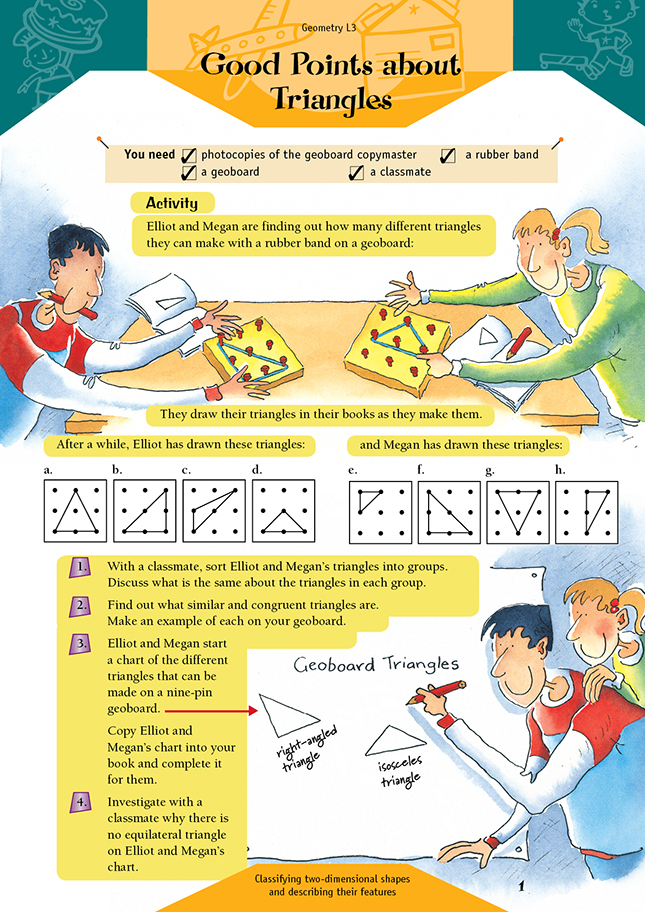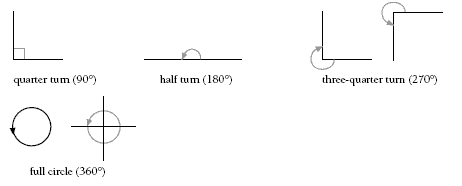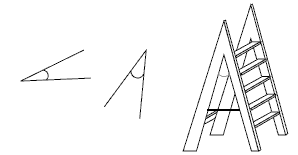This is a Level 3 Geometry activity from the Figure It Out Series.
A PDF of the student activity is included.
Click on the image to enlarge it. Click again to close. Download PDF (113 KB)
- Classify two dimensional shapes and describe their features.
- Copymaster of Geoboards
- A geoboard
- FIO, Level 3, Geometry, Good Points about Triangles, page 1
- A rubber band
The main purpose of this activity is for students to discover the number of different triangles that can be made on a nine-pin geoboard and to be able to classify triangles. Give students the opportunity to both make and draw these triangles because this will reinforce their understanding. (A geoboard copymaster is provided at the back of this book.) Students can easily manipulate and compare triangles when they use a geoboard.
Students should be able to identify isosceles, scalene, right-angled, and acute-angled triangles for question 1.
There are several ideas that you could discuss with the class to increase their understanding of triangles and angles. After students have identified the different groups of triangles, you could discuss what angles are. This builds on quarter and half turns that were covered in level 1 geometry. Use real-life situations to illustrate that an angle is the amount of turn from one line to another, for example:
Students need a good understanding of the amount of turn of a right angle. This will help them to decide whether an angle is greater or less than a right angle. You could also show the students the notation for a right angle:
Next, you could explain degrees: “The Babylonians divided the circle into 360 small parts or sectors.
Each part or sector is called a degree. The symbol for a degree is °.” Find some practical examples, such as a plate (360 degrees), an open birthday card (180 degrees), or a cake with a quarter taken out (90 degrees and 270 degrees), to use with the students to demonstrate the following:
Students can make angles using two cardboard strips and a split pin. They can also relate the angles they create to the quarter turn, half turn, three-quarter turn, and full turn.
An acute angle is a sharply pointed angle that is less than 90 degrees. You could show students different angles and ask them “Is this angle an acute angle? How big might this angle be?” The ability to estimate becomes important here. Students who can do this will have very little trouble using a protractor to measure angles accurately because they are less likely to be confused by the markings on the protractor if they have an estimate to work from.
As an extension, you could introduce the concept of obtuse angles, that is, angles between 90 and 180 degrees.
You can now ask students if there are any ways that they might classify the triangles further, for example, right-angled isosceles or right-angled scalene triangles.
As an extension, you could tell students that the total of a triangle’s three angles is 180 degrees and then ask them questions such as: “In an isosceles right-angled triangle, we know that one of the angles is 90 degrees and the other two angles must be the same size. What would the size of these angles be? What is the total of the three angles?”
Note that for question 3, there are a limited number of triangles that can be made on a nine-pin geoboard. See Answers and Teachers’ Notes: Geometry, Figure It Out, Levels 2–3, page 15 for more comments about rotation, reflection, and translation.
For the investigation given in question 4, students need to realise that the equilateral triangle can’t be made because the two angled lines on the geoboard are slightly longer than the base line. They could then go on to look at extending the triangle into a quadrilateral and looking at the diagonal.
The diagonal of any quadrilateral is always longer than any one of its sides. Any triangle made on a geoboard can be extended into a quadrilateral, with one side of the triangle being the diagonal.
To do further work with triangles, you could:
• Identify triangles in the environment, such as road signs or a girder in a bridge. (You could ask students “Why is the triangle used in construction?”)
• Make links to technology, science, and languages, such as the way the balls are set up in a triangle in the game of pool and the Màori name for a triangle (tahatoru). Taha means sides and the shape is named by the number of sides it has, in this case, three (toru). The word triangle means three angles, with the tri derived from Latin tres and Greek treis (three).
Answers to Activities
- Answers will vary. Possible groupings are:
Group 1: Isosceles triangles (2 sides are the same length)
Group 2: Right-angled triangles (triangles with 1 right angle)
Group 3: Scalene triangles (all the sides are a different length)
Group 4: Acute-angled triangles (triangles with 3 acute angles) - Triangles are similar if they have the same shape.
Triangles are congruent if they have the same
shape and size.
An example of 2 similar triangles is:
An example of 2 congruent triangles is:
- Answers will vary. A possible chart is
.gif)
- Answers will vary. An equilateral triangle cannot be made on a geoboard because 2 sides will always be longer than the third side. An equilateral triangle has all sides and angles congruent.







